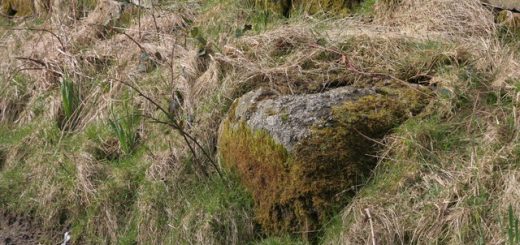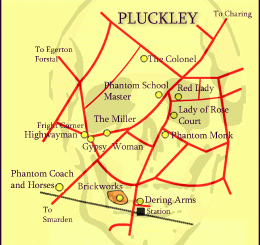Mother Ludlam’s Cave
Mother Ludham’s Cave, was so named after the White Witch that was said to live in it. This small sandstone cave can be found in the Wey Valley and is also associated with the ruined Cistercian Waverley Abbey, or more correctly the spring inside it is associated with the monks that lived there. This spring was known as Ludwell and later St Mary’s Well.
 According to the ‘Antiquarian Repertory: A Miscellany, Intended to Preserve and Illustrate Several Valuable Remains of Old Times. Adorned with Elegant Sculptures. Vol. I. [-IV.]. (1784)’. ‘LOOKING over the description of Mother Ludlow’s Hole in Mr Grofe’s Antiquities, I find the history of that Aqueduct has escaped him. It is given in the Annals of Waverley in words to the following effect. In this year 1216 not without the great admiration of many the spring of our Lavatory called Ludwell was almost entirely empty and dried up. This spring had during the course of many years copiously supplied all the different offices of our abbey with water its failure therefore being severely felt by the whole house a certain monk named brother Symon applied himself to study by what means this misfortune might be soonest and most conveniently rectified and after much deliberation and assistance from useful council he formed a plan which though difficult he set about with great industry, it was to search for new springs of running water. There being not without much difficulty discovered and with great labour collected together he by his industry caused them all to descend to one place by means of a certain subterraneous duct and there to form not by nature but by art a perpetual running spring which as is apparent to the beholders should never cease to furnish the before mentioned offices of the abbey with plentiful supplies of water. It was named St Mary’s spring. Thus the spring of the new well fixed by the art of brother Symon now flows constantly under the hill its course being directed by a pipe.’
According to the ‘Antiquarian Repertory: A Miscellany, Intended to Preserve and Illustrate Several Valuable Remains of Old Times. Adorned with Elegant Sculptures. Vol. I. [-IV.]. (1784)’. ‘LOOKING over the description of Mother Ludlow’s Hole in Mr Grofe’s Antiquities, I find the history of that Aqueduct has escaped him. It is given in the Annals of Waverley in words to the following effect. In this year 1216 not without the great admiration of many the spring of our Lavatory called Ludwell was almost entirely empty and dried up. This spring had during the course of many years copiously supplied all the different offices of our abbey with water its failure therefore being severely felt by the whole house a certain monk named brother Symon applied himself to study by what means this misfortune might be soonest and most conveniently rectified and after much deliberation and assistance from useful council he formed a plan which though difficult he set about with great industry, it was to search for new springs of running water. There being not without much difficulty discovered and with great labour collected together he by his industry caused them all to descend to one place by means of a certain subterraneous duct and there to form not by nature but by art a perpetual running spring which as is apparent to the beholders should never cease to furnish the before mentioned offices of the abbey with plentiful supplies of water. It was named St Mary’s spring. Thus the spring of the new well fixed by the art of brother Symon now flows constantly under the hill its course being directed by a pipe.’
![Weydonian at English Wikipedia [CC BY 3.0 (https://creativecommons.org/licenses/by/3.0)]](http://www.mysteriousbritain.co.uk/wp/wp-content/uploads/2015/07/Mother_Ludlams_Cave_2005-300x225.jpg) The poet Jonathan Swift (30 November 1667 – 19 October 1745) is said to have visited the cave whilst he courted Esther Johnson, who was the daughter of the housekeeper of Sir William Temple (25 April 1628 – 27 January 1699) of Moor Park, Farnham. They used to sit by the well or spring which inspired him to write an ode entitled ‘A Description of Mother Ludwell’s Cave’.
The poet Jonathan Swift (30 November 1667 – 19 October 1745) is said to have visited the cave whilst he courted Esther Johnson, who was the daughter of the housekeeper of Sir William Temple (25 April 1628 – 27 January 1699) of Moor Park, Farnham. They used to sit by the well or spring which inspired him to write an ode entitled ‘A Description of Mother Ludwell’s Cave’.
According to tradition, the witch, Mother Ludlam lived in the cave and is associated with the story of a cauldron which can be found in Frensham Parish Church. In some versions of the story, the cauldron belonged to Mother Ludlam and one day the devil wearing a disguise tried to borrow the cauldron. Mother Ludlam, realised her visitor’s true identity and refused the request. The Devil then stole the cauldron and fled the scene of the crime with Mother Ludlam in pursuit. The Devil dropped the cauldron on Kettlebury Hill after creating the hills known as the Devil’s Jumps around Churt with his huge leaps. In order to protect her cauldron from the Devil, Mother Ludlam placed it in Frensham Parish Church after she had recovered it from Kettlebury Hill.
 Alternatively the cauldron was left in the church by someone who had borrowed it from Mother Ludham. In order to avoid her anger for not returning it on time, he fled into the church for sanctuary and the cauldron has remained there since.
Alternatively the cauldron was left in the church by someone who had borrowed it from Mother Ludham. In order to avoid her anger for not returning it on time, he fled into the church for sanctuary and the cauldron has remained there since.




Recent Comments